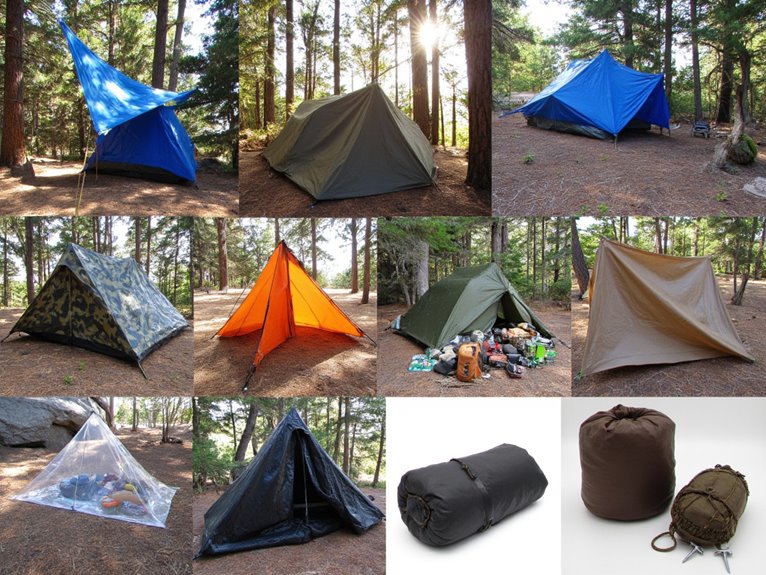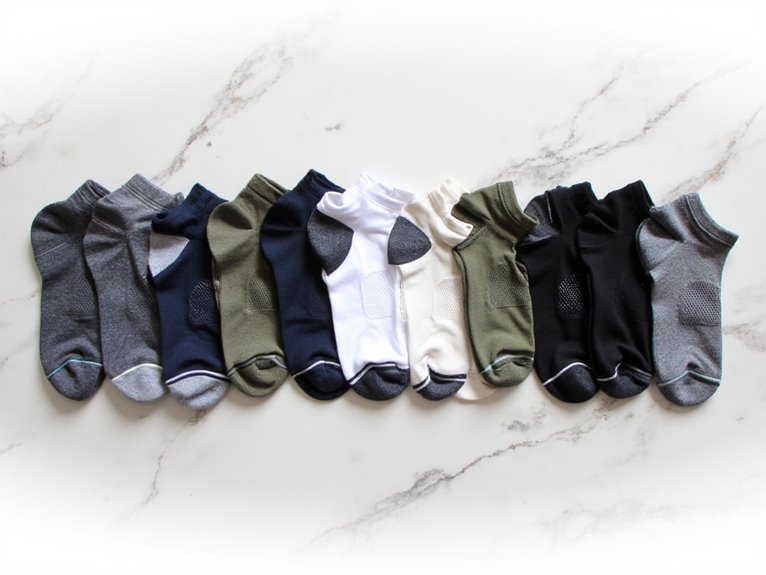How Many Miles Should You Run in Trail Shoes?
Trail shoes have a limited lifespan, typically ranging from 300 to 500 miles, depending on factors like runner's weight, running style, and terrain. Monitoring shoe condition is vital, paying attention to signs of wear like sole degradation, midsole compression, and upper material deterioration. Factors like terrain, climate, and frequency of use substantially impact shoe durability. Understanding these factors is essential to maximizing shoe mileage and preventing injuries. By grasping the intricacies of trail shoe durability, runners can optimize their performance and make certain of a safe, successful running experience.
We are supported by our audience. When you purchase through links on our site, we may earn an affiliate commission, at no extra cost for you. Learn more. Last update on 16th January 2026 / Images from Amazon Product Advertising API.
Understanding Trail Shoe Durability
Trail shoes, like tires on a rugged terrain vehicle, have a limited lifespan that's directly tied to the number of miles they can handle before needing replacement.
Understanding the durability of trail shoes is vital for runners to maintain peak performance and prevent injuries.
The lifespan of trail shoes depends on various factors, but generally, they can last anywhere from 300 to 500 miles, depending on the runner's weight, running style, and terrain.
It's essential to monitor the shoe's condition, paying attention to signs of wear, such as sole degradation, midsole compression, and upper material deterioration.
Factors Affecting Shoe Mileage
When evaluating the lifespan of trail shoes, it's essential to think about the factors that influence their mileage.
The conditions under which you run, including terrain, climate, and frequency, substantially impact shoe durability.
Moreover, the quality of the shoes themselves, including materials and construction, also play a vital role in determining their overall mileage.
Running Conditions Matter
Runners who tackle rugged terrain, extreme temperatures, and inclement weather conditions can expect their trail shoes to have a significantly shorter lifespan.
The constant pounding on rocky trails, exposure to freezing temperatures, and trudging through wet and muddy conditions all take a toll on the shoe's materials.
Additionally, running in sandy or dusty conditions can accelerate wear on the outsole and midsole.
These harsh conditions cause the shoes to degrade faster, leading to reduced cushioning, compromised support, and increased risk of injury.
As a result, runners who frequently encounter such conditions should plan to replace their trail shoes more frequently to maintain peak performance and safety.
Shoe Quality Variance
The durability and mileage of trail shoes can vary substantially depending on the quality of the shoe itself, with high-quality models often capable of withstanding markedly more miles than their lower-end counterparts.
The quality of the shoe's materials, construction, and design all play a significant role in determining its overall lifespan.
The following factors impact shoe durability:
- Materials: High-quality shoes often feature more durable and resistant materials that can withstand the rigors of trail running.
- Cushioning: Better quality shoes typically have more effective cushioning systems that absorb shock and reduce wear and tear.
- Tread pattern: Aggressive tread patterns can provide better traction but may wear down faster, while more subtle patterns may last longer.
- Build quality: Well-constructed shoes with secure stitching and bonding can withstand the demands of trail running for longer periods.
Average Mileage for Trail Shoes
When it comes to determining the average mileage for trail shoes, several key factors come into play.
The conditions under which you run, the quality of your shoes, and your individual characteristics, including your weight, all impact the lifespan of your trail shoes.
Understanding the interplay between these factors is crucial to maximizing the mileage you can expect from your trail shoes.
Trail Conditions Matter
Depending on the ruggedness of the terrain, trail conditions can substantially impact the lifespan of your shoes, with rocky, root-ridden, and slippery trails potentially reducing their mileage by as much as 20-30%.
This is because harsh trail conditions can cause excessive wear on the outsole, midsole, and upper materials.
Trails with sharp rocks and roots can cause cuts and abrasions on the outsole and midsole.
Slippery trails can lead to increased lateral movement, putting additional stress on the upper materials.
Steep inclines can cause increased wear on the heel and forefoot.
Trails with loose debris can clog the tread pattern, reducing traction and increasing the risk of slipping.
Shoe Quality Counts
High-quality trail shoes, designed with durable materials and robust construction, can withstand the rigors of trail running, often logging substantially more miles than their lower-end counterparts.
The superior craftsmanship and premium materials used in high-end shoes enable them to absorb the impact of trail running, reducing wear and tear on the shoe.
As a result, high-quality trail shoes can comfortably reach 400-500 miles or more before significant degradation occurs.
In contrast, lower-end shoes may only last for 200-300 miles before showing signs of excessive wear.
Investing in high-quality trail shoes is essential for trail runners who log high mileage, as they provide better protection, support, and durability.
Runner's Weight Impacts
A runner's weight plays a significant role in determining the average mileage of their trail shoes, as increased weight and impact force accelerate wear and tear on the shoes, leading to a shorter lifespan.
This means that heavier runners will generally need to replace their shoes more frequently than lighter runners.
Lightweight runners (<130 lbs): May get up to 500 miles out of their trail shoes
Average-weight runners (130-180 lbs): Typically get around 300-400 miles
Heavier runners (180-220 lbs): May need to replace shoes every 200-250 miles
Very heavy runners (>220 lbs): May only get 100-150 miles out of their trail shoes
Trail Conditions and Wear Patterns
Trail conditions, ranging from rugged mountain terrain to smooth dirt paths, substantially influence the wear patterns on trail shoes.
The more aggressive the terrain, the faster the wear. Rocky and technical trails, for instance, can lead to accelerated wear on the outsole and midsole, particularly in the forefoot and heel areas.
In contrast, smooth and well-maintained trails can result in more even wear patterns. Additionally, weather conditions, such as wet and muddy trails, can also impact wear patterns.
Understanding the trail conditions you typically run on is essential in determining the lifespan of your trail shoes. By considering these factors, you can better estimate the mileage you can expect from your shoes.
Running Style and Its Impact
Every runner's unique biomechanics and running style have a profound impact on the wear and tear of their trail shoes, with factors such as foot strike, stride length, and cadence all playing a significant role in determining the lifespan of the shoes.
Runners with heavy foot strikes, for example, may experience faster wear on the heel and forefoot areas, while those with shorter strides may see more even wear patterns.
Heavy heel strikers: Expect increased wear on the heel and forefoot.
Forefoot strikers: Typically experience more even wear patterns.
High-cadence runners: May see increased wear on the midsole and outsole.
Overstriders: Often experience excessive wear on the heel and toe areas.
Shoe Quality and Materials Matter
The durability and performance of trail shoes are substantially influenced by the quality of materials and construction, with superior materials and craftsmanship leading to longer-lasting shoes that can withstand the rigors of regular use.
High-quality shoes typically feature durable outsoles, breathable uppers, and cushioning systems designed to absorb shock and distribute pressure.
Premium materials, such as full-grain leather and advanced midsole compounds, provide added durability and responsiveness.
Additionally, a well-constructed shoe with a secure fit and adequate support can help reduce the risk of injury and improve overall performance.
Signs It's Time for Replacement
As trail shoes accumulate miles, subtle signs of wear can become apparent, indicating it's time to think about replacement.
Two key indicators of a shoe's lifespan are worn-out midsoles and visible sole damage, which can notably impact performance and comfort.
Worn-Out Midsoles
Worn-out midsoles often manifest as a subtle yet unmistakable loss of cushioning, signaling that it's time to replace your trail shoes. This decline in midsole performance can lead to discomfort, fatigue, and even injuries.
To identify worn-out midsoles, look for these signs:
- Reduced bounce and responsiveness
- Heavier, more labored strides
- Increased pressure on joints and muscles
- Noticeable decrease in overall comfort
If you're experiencing any of these symptoms, it's likely that your trail shoes have reached the end of their lifespan. Replacing them with a new pair will help restore peak performance and comfort, ensuring a healthier and more enjoyable running experience.
Visible Sole Damage
How many miles can you reasonably expect to get out of your trail shoes before visible sole damage sets in, signaling the need for replacement?
Visible sole damage is a clear indication that your shoes have reached the end of their lifespan. Look for signs such as excessive wear on the heel and ball of the foot, worn-down tread patterns, and deep grooves on the outsole.
If you notice any of these signs, it's time to replace your shoes. Failure to do so can lead to reduced traction, increased risk of injury, and decreased performance.
Regularly inspect your shoes for visible sole damage to maintain peak performance and safety on the trails.
Tips for Extending Shoe Life
Properly caring for your trail shoes can substantially extend their lifespan, saving you money and reducing waste. By following a few simple tips, you can get the most out of your shoes and delay the need for replacement.
Clean your shoes regularly to remove dirt and debris that can cause damage.
Allow your shoes to air dry after use, rather than exposing them to direct heat.
Store your shoes in a cool, dry place away from direct sunlight.
Rotate your shoes with other pairs to give them time to recover and rebound between uses.
Budgeting for Trail Shoe Replacement
Regularly setting aside a budget for trail shoe replacement is crucial to guarantee uninterrupted performance and comfort on the trails.
A well-planned budget guarantees that you can replace your shoes as needed, preventing premature wear and tear on your body.
Calculate your annual trail running mileage and divide it by the average lifespan of your trail shoes to determine how many pairs you'll need to purchase each year.
Allocate a specific amount for each pair, considering factors such as quality, brand, and sales tax.
Set aside a fixed amount each month to guarantee that you're prepared when it's time to replace your shoes.
Creating a Shoe Rotation Plan
By allocating a specific budget for trail shoe replacement, you can now focus on implementing a shoe rotation plan that promotes peak performance and minimizes the risk of overuse injuries.
A well-structured rotation plan guarantees that you're always wearing the right shoe for the job, while also allowing each pair to recover and maintain their performance.
*Identify your primary running shoes and designate them for high-intensity workouts*
*Assign secondary shoes for recovery runs and easy training days*
*Alternate between shoes to allow for recovery and maintenance*
*Schedule regular cleaning and maintenance to extend shoe lifespan and facilitate optimal performance*



